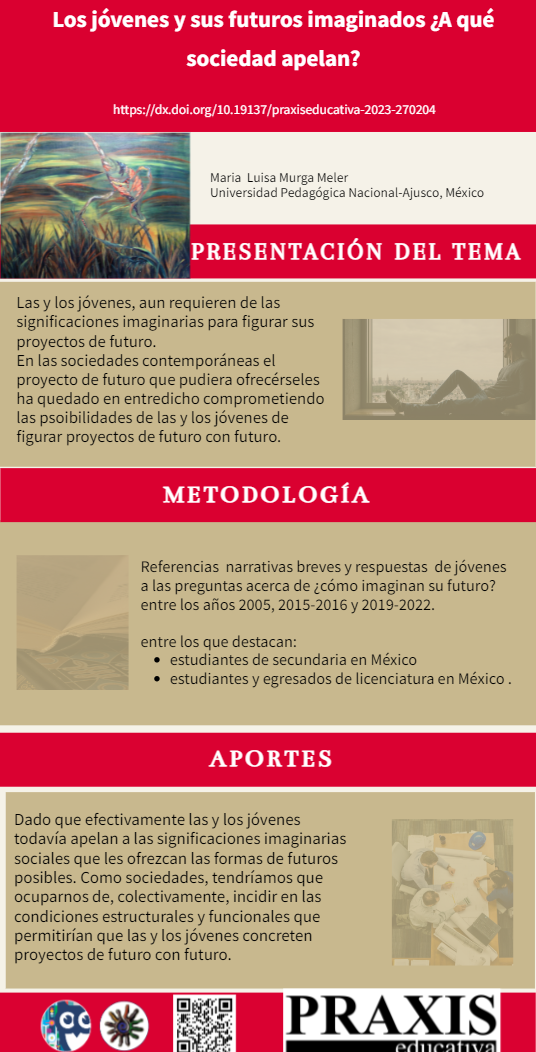Los jóvenes y sus futuros imaginados. ¿A qué sociedad apelan?
DOI:
https://doi.org/10.19137/praxiseducativa-2023-270204Palabras clave:
Jóvenes, Sociedad futura, Significaciones imaginarias, Proyectos de vida, Proyectos de formaciónResumen
En su institución, las sociedades crean su propia temporalidad como emergencia de alteridad y diferencia, lo
que implica no solo su presente, sino también un proyecto para la sociedad y los individuos. Sin embargo,
con la expansión del capitalismo neoliberal que emprende la evacuación del pasado, el tiempo presente se
constituye como tiempo único e infinito, por lo que se compromete el proyecto de futuro que la sociedad
ofrecería a los sujetos. Desde esta perspectiva y con base en lo que plantean jóvenes mexicanos sobre el
futuro, el artículo reflexiona sobre el proyecto que la sociedad contemporánea ofrece a las y los jóve nes,
quienes, en sus procesos de constitución, apelan a las significaciones imaginarias que la sociedad tiene para
ofrecerles, para conformarse como sujetos y articular sus deseos en proyectos de futuro con futuro.
Descargas
Citas
Ariés, P. (2001). El niño y la vida familiar en el Antiguo Régimen. Taurus.
Castelain-Meunier, C. (2003). Padres, madres hijos. Siglo XXI.
Castoriadis, C. (1997a). El Mundo Fragmentado. Altamira.
Castoriadis, C. (1997b). El avance de la insignificancia. Eudeba.
Castoriadis, C. (1999). La institución imaginaria de la sociedad. (2 Vols.). Tusquets.
Castoriadis, C. (2001). Figuras de lo pensable. Fondo de Cultura Económica.
Coffey, A. y Atkinson, P. (1996). Making Sense of Qualitative Data. Complementary Research Strategies. SAGE.
Deleuze G. (2014). Conversaciones. Pre-Textos.
Durkheim, É. (1982). La división del trabajo social. Akal.
Instituto Mexicano de la Juventud. (IMJ) (2006). Encuesta Nacional sobre Juventud 2005. Tabulados básicos. Instituto Mexicano de la Juventud.
Instituto Mexicano de la Juventud/Secretaría de Educación Pública, (IMJ/SEP) (2011). Encuesta Nacional de Juventud 2010. Resultados generales. Instituto Mexicano de la Juventud/Secretaría de Educación Pública.
León-Portilla, M. (2003) Niñez y juventud entre los nahuas. Arqueología mexicana, X (60), 22-29.
León-Portilla, M. (2011). Huehuehtlahtolli. Testimonios de la antigua palabra. Fondo de Cultura Económica.
López, A. y López, L. (1996). El pasado indígena. El Colegio de México/Fondo de Cultura Económica.
Mead, M. (2006). Cultura y compromiso. Estudio sobre la ruptura generacional. Gedisa.
Mier, R. (octubre 2017). Regímenes de intercambio y formas de valor. Emancipación y formas de control. En UAM-X. Coloquio internacional: EL CAPITAL, 150 AÑOS. Reflexiones sobre la sociedad y el capital en el siglo XXI. Coloquio llevado a cabo en la Universidad Autónoma Metropolitana, Unidad Xochimilco, México.
Turner, V. (1997). La selva de los símbolos. Siglo XXI.
Ricoeur, P. (1979). Introducción. En Ricoeur, P.; Aguessy, H.; Hama, B.; et. al. El tiempo y las filosofías (pp. 11-35), UNESCO-Ediciones Sígueme.
Rocha, G. y Murga, M. L. (2004). Deseo, vínculo social y creación colectiva. Tramas, 21, 161-177.
Virilio, P. (2005). El cibermundo, la política de lo peor. Cátedra.

Descargas
Publicado
Número
Sección
Licencia
Nota de copyright
Comité Editorial Revista Praxis educativa:
Por la presente declaro que soy autor del artículo titulado (nombre del artículo), que el mismo es original y propio y que no fue publicado en ningún otro formato o soporte con anterioridad. Manifiesto conocer que la revista no me cobrará ningún tipo de tasa bajo ningún concepto, ni recibiré ningún tipo de compensación monetaria
Si el mismo fuera aceptado para su publicación en Praxis educativa, autorizo a la referida revista a publicarlo en forma digital y a publicitarlo en sus redes sociales.
Si el trabajo fuera publicado, adhiero a la licencia Creative Commons denominada “Atribución - No Comercial Compartir igual CC BY-NC-SA”, mediante la cual se permite copiar, reproducir, distribuir, comunicar públicamente la obra y generar obras derivadas, siempre y cuando se cite y reconozca al autor original. Esta licencia se utiliza desde septiembre 2018. En 2016 se adhirió a CC BY NC ND 4.0; y en años 2017 y 2018 (enero -agosto) CC BY NC 4.0..
Esta licencia CC BY-NC-SA Compartir igual no permite, sin embargo, utilizar la obra con fines comerciales. Como autor la revista podré establecer acuerdos adicionales para la distribución no exclusiva de la versión de la obra publicada en la revista me permite el autoarchivo de los artículos publicados, en su versión post-print, en repositorios institucionales, temáticos, páginas web personales o cualquier otro uso pertinente. con el reconocimiento de haber sido publicado primero en esta revista.
Praxis educativa adhiere a DORA (Declaration on Research Assessment) firmada en San Francisco, California, el 16 de diciembre de 2012, y a la Declaración de México (Declaración Conjunta LATINDEX - REDALYC - CLACSO - IBICT).














_(1)2.png)


3.png)










_(2).png)






2.jpg)
8.png)









